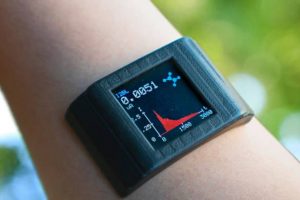The Defense Advanced Research Projects Agency (DARPA) has teamed up with Massachusetts-based Draper to streamline the design of microbe-based electronic sensors. “Microbes have the potential to be developed as biological sensors that can collect vital information about the environments they naturally inhabit,” said Draper biotechnologist Chris Vaiana. “Our goal is to support DARPA in mapping the modular design of microbe-based ...
Tag Archives: Bioelectronics
Chip analyses human white blood cells
Imec has teamed up with Sarcura, an Austrian start-up, to build an white blood cell analyser-on-a-chip using integrated photonics. Resolution is sufficient to discriminate between lymphocytes and monocytes, “rivaling the performance of commercial cytometers”, said Imec scientific director Niels Verellen. It is a flow cytometer and is based on the scattering of a laser beam though a sample. The intensities ...
Don’t throw this battery away, eat it
Researchers at the Istituto Italiano di Tecnologia (IIT) have made an edible rechargeable battery from things already eaten by humans. Inspiration came from biological redox reactions that happen inside living beings, and for an energy source the team picked bio-materials with the highest and lowest redox reduction potentials: riboflavin for the anode and quercetin for the cathode. Riboflavin is vitamin ...
That robot finger with living skin
Researchers at the University of Tokyo have grown a skin-like layered material from bio-materials found in human skin. The result, demonstrated on a robot finger, self-fits to the underlying structure, is flexible, soft to the touch, and shows some self-healing properties. A 3D printed three-jointed finger, later operated by nylon threads running through it, was used as a scaffold for ‘skin’ ...
A new approach to skin chemistry sensing
Engineers at University of California Los Angeles have found a way to create a stretchable adhesive skin chemistry sensor without serpentine electrical conductors. Instead, they persuaded the liquid sweat to pipe itself sideways through a flexible film layer between electrodes – maintaining stretchability – while electrical connections are made through the thickness of the sensor to a rigid electrode array at the ...
Sensor e-skin powered by sweat
Sensing electronic skin can be powered by the sweat in its environment, according to the California Institute of Technology. “One of the major challenges with these kinds of wearable devices is on the power side,” said CalTech research engineer Wei Gao. “Many people are using batteries, but that’s not very sustainable. Some people have tried using solar cells or harvesting ...
Stretchy electronic tattoo technique suits prototyping
Seeking a fast route to stretchable circuits with integrated electronics for on-skin use, a team from Portrugal and the US have developed a technique that avoids clean rooms and photo lithography. Instead, the required conductive pattern is printed onto temporary tattoo paper with an ordinary desktop laser printer. Next, a silver pasted is rubbed onto the print, where it adheres ...
Maxim senses breathing, pulse, blood oxygen and more for wearables
Maxim is aiming at medical wearables with a set of chips for sensing various vital signs. In particular, its chips are aimed at wearables that meets US Fedral Drug Administration (FDA) sensing specifications – so far, said Maxim, no wearables have achieved FDA approval. MAX86141 is an autonomous dual-channel (for two photodiodes) optical pulse oximeter plus heart rate sensor, measuring ...
Bioelectronic nerve stimulator eases rheumatoid arthritis
Electronic nerve stimulation has had a calming effect on rheumatoid arthritis, beating the best drugs in some patients. The study involved implanting signal generator connected to the vagus nerve. Stimulation was found to reduced the production of proteins called cytokines. “This is a real breakthrough in our ability to help people suffering from inflammatory diseases,” said Dr Kevin Tracey, CEO of ...
 Electronics Weekly Electronics Design & Components Tech News
Electronics Weekly Electronics Design & Components Tech News








